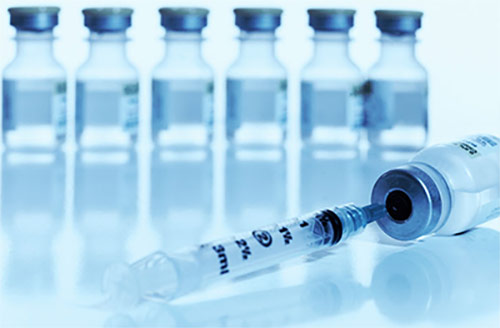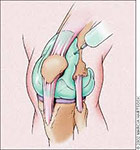|
Joint injection & aspiration

Fast Facts

- Joint aspiration is used in a physician office to take out the joint fluid from a swollen joint.
- Joint injections are used to deliver steroids directly into a joint, such as a knee, ankle, or wrist. Sometimes fluid is removed from the joint before the steroid is injected.
- Aspirated joint fluid can help your physician diagnose the cause of the swelling joint.
- Steroid joint injections can help with pain and swelling by treating the underlying joint inflammation - improvement is often FAST!
- The risks for joint aspirations and injections are minimal. Infection, bleeding, and other major risks are rare.
Joint injections or aspirations (taking fluid out of a joint) are performed in an office or hospital setting, often with a cold spray or other local anesthesia. After the skin surface is thoroughly cleaned, a needle in injected directly into a joint. At this point, either joint fluid can be removed (aspirated) and used for appropriate laboratory testing, or steroids can be injected into the joint. The steroid treats the inflammation inside the joint, leading to decreased swelling and pain.
Commonly injected joints include the knee, shoulder, ankle, elbow, wrist, base of the thumb, and small joints of the hands and feet. Hip joint injection may require the aid of an ultrasound or X-ray called fluoroscopy for guidance. Some small joints may also be more easily aspirated or injected with aid of ultrasound.
What is a joint aspiration or joint injection?

Steroid joint injections can be used as part of a treatment plan for people with arthritis. A steroid medication is injected using a needle directly into a joint, such as a knee. The steroid treats the inflammation inside the joint, leading to decreased swelling and pain.
Sometimes joint fluid is removed before the steroid is injected (called aspiration), and then the steroid is injected into the joint, without requiring a new needle stick. Fluid obtained from a joint aspiration can be examined by the physician or sent for laboratory analysis, which may include a cell count (the number of white or red blood cells), crystal analysis (to confirm the presence of gout or calcium pyrophosphate crystal disease), and/or culture (to determine if an infection is present inside the joint). Drainage of a large joint effusion can provide pain relief and improved mobility.
The decision to use joint injections as part of a treatment depends on each individual case. Joint injections may decrease the accumulation of fluid and cells in the joint and may temporarily decrease pain and stiffness. This procedure only treats the joint or joints that the steroid is injected into. The positive effects of steroid injections are not permanent. Often, the improvement in inflammation, swelling and joint pain lasts for a few months before wearing off. In some milder conditions, a joint injection may produce longer periods of disease control.
Joint injections may be given to treat inflammatory joint conditions, such as rheumatoid arthritis, psoriatic arthritis, gout, tendonitis, bursitis and, osteoarthritis.
How is a Joint Injection usually given?
Joint injections can be performed in the clinic, in a procedure room, or sometimes in an operating room if many joints will be injected. It is important for the patient to stay as still as possible during the procedure. Hyaluronic acids and corticosteroids (such as methylprednisolone and triamcinolone formulated to stay primarily in the joint) are frequently used. Corticosteroids are anti-inflammatory agents that slow down the accumulation of cells causing inflammation and pain within the joint space.
When it is time for the injection, the skin at and around the injection site will be carefully cleaned to remove bacteria from the skin. A needle is then inserted into the joint space. If the plan is to remove fluid, an empty syringe will be attached to the needle to pull the fluid out. Sometimes, multiple syringes need to be used to remove all the fluid. The same needle stays in place throughout the procedure. After any necessary fluid is removed, a small syringe containing the steroid is attached to the needle and the steroid is slowly injected into the joint. The needle is removed, and pressure is held to prevent bleeding or leaking of the steroid. A bandage is applied to the injection site. If the injection was performed awake, you are all done! If the child was sedated, there is some wake-up time and monitoring required.
In some cases, joint injections are performed under guidance of ultrasound or a special type of X-ray called fluoroscopy, especially for joints that are difficult to inject such as hips, shoulders, or TMJs (the jaw).
Possible Risks/Side Effects
Occasional side effects include allergic reactions to the medicines injected into joints, tape or the disinfectant used to clean the skin. Infections are extremely rare complications of joint injections and occur less than 1 time per 15,000 corticosteroid injections. Another uncommon complication is post-injection flare - joint swelling and pain several hours after the corticosteroid or hyaluronic acid injection - which occurs in approximately 1 out of 50 patients and usually subsides within several days. It is not known if joint damage may be related to too-frequent corticosteroid injections. Some patients may have a temporary increase in pain that can last a few days and is usually manageable with an NSAID, such as ibuprofen or naproxen (or Tylenol in a patient already taking scheduled NSAIDS).
Generally, repeated and numerous injections into the same joint/site should be discouraged. Other complications, may include depigmentation (a whitening of the skin), local fat atrophy (thinning of the skin) at the injection site and rupture of a tendon near the injection site.
Joint injections also should not be given if an infection is present inside or around a joint and if someone has a serious allergy to one or more of the medications that are injected into a joint. If an infection is suspected, aspirating the joint to gather cultures is essential. Be sure to let your doctor know if you have previously had an allergic reaction to a steroid medication, a sterilizing soap (such as betadine or chlorhexidine), lidocaine or adhesives.
|




